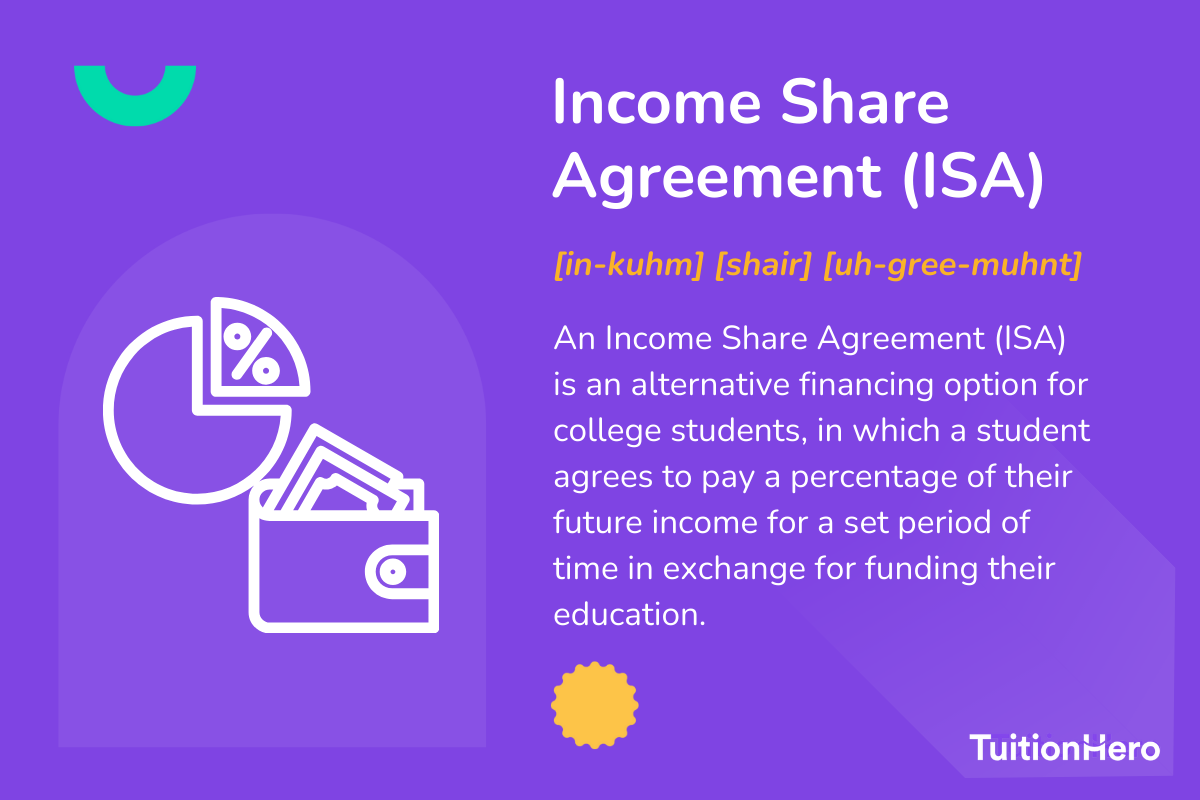Advertiser Disclosure
Last update: June 11, 2025
8 minutes read
What Is an Income Share Agreement (ISA)?
Master income share agreements with real borrower case studies, tax deduction insights, and FAFSA guidance. Discover how ISAs can optimize your college funding strategy today.

By Brian Flaherty, B.A. Economics
Edited by Rachel Lauren, B.A. in Business and Political Economy
Learn more about our editorial standards



By Brian Flaherty, B.A. Economics
Edited by Rachel Lauren, B.A. in Business and Political Economy
Learn more about our editorial standards
If you’ve ever googled "what is an income share agreement", you know income share agreements tie your education funding to your future earnings, creating both opportunities and risks.
Before committing, it’s wise to explore how income share agreements work and see how they have played out for real graduates across different fields.
Below, you’ll find borrower case studies that reveal potential savings and pitfalls—and a clear look at ISA loan tax and aid implications. These insights will help you choose between traditional student loans and ISA student loans with confidence.

Key takeaways
- Income-share agreements offer an alternative to traditional student loans with repayments based on future income, rather than a particular interest rate on the principal balance
- Key features of ISAs include income-share rate, salary floor, payment cap, and repayment term
- Racial disparities have been observed in ISAs, necessitating careful scrutiny of terms by minority students
What is an income share agreement (ISA)?
An Income Share Agreement (ISA) is a college financing option. In an ISA, you repay a percentage of your future income instead of a loan. This method aligns your educational investment with your career success.

How do you apply for an income share agreement?
Applying for an ISA typically involves several steps. First, find out if your school or career program offers ISAs. ISAs are seen most commonly at vocational schools and boot camps; while some traditional universities offer ISA programs, it's not as common.
Purdue University's "Back a Boiler" program is one example. Certain private financiers like Stride Funding also offer ISAs.
Second, gather your necessary documents, like proof of enrollment and identification. The ISA provider will let you know what documents they will need. Note that we do not call them “lenders”, as an ISA isn't technically a loan, according to law.
Required documentation and eligibility criteria
You generally need to provide information about your field of study, projected graduation date, and sometimes your estimated future earnings. ISAs don’t require a cosigner, a credit check, or even a high credit score.
This makes them accessible to a broad range of students, especially those who may have exhausted other financing options. However, that does mean that the implied interest rate from the ISA may be much higher than a traditional loan.
What makes a good income share agreement?
A favorable ISA usually has clear, student-friendly terms. Look for ISAs with an income-share rate below 10%, a salary floor that matches your expected entry-level salary, and a payment cap of fewer than two times the borrowed amount. If you make below the salary floor, you do not have to make payments during that time, aligning incentives between you and your ISA counterparty.
Understanding the repayment terms
Repayment terms should align with your career prospects. For example, Stride Funding has a salary floor of around $30-40K depending on your specific agreement, meaning you’ll only start repaying once you hit that annual income. Another crucial element is the repayment term duration, which typically ranges from two to ten years.
How do income share agreements affect taxes and financial aid?
Currently, payments under an income share agreement aren’t tax-deductible under IRS rules, unlike student-loan interest. If Congress later classifies ISAs as “qualified education loans,” that could open the door to future deductions.
On the FAFSA, ISAs generally don’t count as loans or scholarships, but each school may treat them differently; always compare the best income share agreements with your other aid options.

TuitionHero Tip
Some institutions may reduce need-based aid by your ISA amount, so confirm details with your financial aid office.
Real-world borrower case studies
Sarah graduated in 2021 with a Mechanical Engineering degree and chose a 4% income-share over five years with a 1.8x cap. By tying her payments to her salary, she paid $18,000 on a $12,000 advance—about $2,000 less than she would've under a standard 5% APR ISA student loan.
Carlos finished his Graphic Design program in 2022 under an 8% share, a seven-year term, and a 2x cap. His income occasionally dipped below the salary floor, pausing payments unpredictably and extending his timeline—illustrating the risk of under-floor income pauses in any ISA agreement.
Amina completed a Data Science bootcamp in 2023 with a 10% share for two years and a 1.5x cap. Rapid salary increases let her repay her $10,000 advance in just 18 months, demonstrating how fast-growing fields can accelerate ISA payoff but may increase total cost for top earners and why comparing income share agreements student loans options matters.

Concerns about racial disparities in ISAs
ISA programs have faced criticism for potential racial disparities. A study by the Student Borrower Protection Center found that Stride Funding's ISAs charged higher rates to students from historically Black colleges. For instance, a computer science major at Tuskegee University was quoted $2,802 higher for a $10,000 ISA compared to a peer at Auburn University.

TuitionHero Tip
This data highlights the fact that although ISAs can be a tool to expand access to education funding, some ISA providers might still unfairly discriminate against certain students.
Effect of discrimination on repayment rates
Discrimination based on race, gender, or field of study can skew repayment rates. This is crucial to consider if you're a student from a minority background attending a minority-serving institution. Carefully comparing terms between different ISA providers and ensuring that you’ve received an equitable ISA financing offer can help mitigate this risk.
The history and future of ISAs
The concept of ISAs dates back to a 1955 essay by economist Milton Friedman. He proposed financing education similarly to how investors provide capital to businesses - with the expectation of a return based on future profits. By 2019, over $250 million worth of ISAs had been originated.
Evolution and the current landscape
Currently, ISAs are available through a limited number of universities, coding bootcamps, and other career schools. Given the rising student loan debt (which is currently at an all-time high), ISAs provide a compelling, albeit niche, alternative. Experts like Tonio DeSorrento from Vemo Education estimate that around 50 colleges currently offer ISAs.
What pitfalls should you watch out for?
The market for ISAs is largely unregulated, since it isn't a traditional loan product. This can lead to practices that may be detrimental to students. Some ISA providers might use harsh collection methods, charge excessive fees, or even set off the debt against your state tax refund if you default.
Checklist for avoiding pitfalls
To avoid these risks, read the fine print carefully. Make sure the terms regarding repayment caps, income-share rates, and salary floors are clearly defined and reasonable.
Always compare ISAs with traditional loans and other financial aid, like federal student loans or private loans. For more insights on optimizing your college financing, visit our detailed guide on selecting the right student loan refinancing options.
Compare private student loans now
TuitionHero simplifies your student loan decision, with multiple top loans side-by-side.
Compare Rates
Data table
The table below summarizes key data points and features of ISAs. This quick reference can help you understand the crucial aspects of ISAs at a glance.
Feature | Details |
|---|---|
Income-Share Rate | 2% to 10% of future income |
Salary Floor | Minimum income to start repayment, e.g., $30,000-40,000 at Stride Funding |
Payment Cap | Usually up to 2x the borrowed amount |
Repayment Term | Generally 2 to 10 years |
Popular Providers | Edly, Stride Funding, Align |
Disbursement | Up to $25,000 per school year through private financiers like Stride |
History | Concept by Milton Friedman (1955); $250M ISAs originated by 2019 |
Access Requirement | No cosigner or credit check needed |
Usage Conditions | Usually after exhausting federal student aid |
Dos and don'ts of income share agreements (ISAs)
When considering an Income Share Agreement (ISA) for your education financing, it's crucial to understand the key features and potential pitfalls. Below, we've outlined essential dos and don'ts to help you make an informed decision and secure the best financial future.
Do
Compare ISA terms carefully, especially income-share rates and payment caps.
Verify the ISA's salary floor to ensure it aligns with your expected starting salary.
Check if the ISA provider has any known biases or disparities in their offers.
Explore ISAs alongside other financial aid options like federal student loans.
Don't
Ignore the fine print regarding repayment terms and conditions.
Assume all ISAs are better than traditional student loans without comparison.
Overlook the potential lack of regulation in the ISA market.
Forget to consider long-term career prospects when evaluating ISA terms.

Advantages and disadvantages of income share agreements (ISAs)
Explore the benefits and drawbacks of Income Share Agreements (ISAs) versus traditional student loans. This guide provides a concise comparison to help you determine the best financing option for your education, focusing on key aspects like repayment terms and accessibility.
- Repay based on income: Payments are tied to a percentage of future income, potentially easing the burden if earnings are low.
- No credit requirements: ISAs do not require a credit check, making them accessible to students without strong credit histories.
- No payments under salary floor: If you earn below a certain amount, you don't have to make payments.
- No cosigner needed: Students can secure ISAs without a cosigner, unlike many traditional loans.
- Flexible repayment term: ISAs generally have a fixed term, and payments stop after the term ends, regardless of the amount paid.
- Potential high cost: The implied interest rate can be higher than traditional loans, especially for high earners.
- Racial disparities: There have been concerns about discriminatory practices in setting terms for different demographics.
- Lack of regulation: ISAs are not as regulated as traditional loans, potentially leading to less favorable terms for borrowers.
- Repayment uncertainty: The total repayment amount can be unpredictable, as it depends on future income.
- Limited availability: ISAs are not widely available at all institutions, restricting access for many students.

Why trust TuitionHero
At TuitionHero, we help students and parents explore all financial aid options. We provide resources and connect you with lenders for private student loans, refinancing, and scholarships. Our tools simplify navigating FAFSA and finding student-friendly credit card offers. Visit our site to make the best financial choices for your education.
Frequently asked questions (FAQ)
The repayment cap in an ISA sets a maximum limit on the total amount you'll repay. This cap is typically a multiple of the borrowed amount, and it’s usually recommended to avoid ISAs that go above 2x the loan amount.
Always read the terms of your agreement carefully to understand the full implications. Learn more about different student loan options to compare with ISAs.
While ISAs are more commonly found at the undergraduate level, some graduate programs do offer them. As ISAs' popularity grows, schools and private lenders might increasingly extend these agreements to graduate students. For alternative funding options, particularly suited for graduate students, check out our graduate student loans guide.
Most ISAs stipulate that repayments continue regardless of where you live, but the specifics can vary by provider. Make sure to review the terms of your ISA regarding international income and any necessary arrangements for payment. If international plans are a possibility, consider reviewing how these terms will affect your obligations.
Unlike traditional loans, ISAs typically don’t offer refinancing options because repayment depends on future earnings, and not a loan balance with interest. However, understanding your ISA terms clearly before committing can prevent future complications. For refinancing information specific to traditional student loans, see our resources on refinancing student loans.
Yes, ISA terms usually vary depending on your chosen field of study. For instance, students in higher-earning fields like engineering might get better terms compared to those in lower-earning fields.
This variation aims to align repayment with expected income. Explore more about choosing the best financial aid options based on your needs.
An Income Share Agreement (ISA) is a financing contract where a student receives upfront funds for education in exchange for agreeing to pay a fixed percentage of their future income over a set period.
Unlike traditional loans, ISAs don’t accrue interest and payments adjust with your earnings—you pay more when your salary rises and less (or nothing) when it falls below a predefined threshold.
This model aligns the lender’s return with your career success while capping total repayment amounts.
Beyond your income-share rate, some ISAs carry origination or administrative fees that reduce your net funding. Look for upfront setup charges, late-payment penalties if you miss a salary threshold, and any collection or processing fees capped in your contract. Always request a full fee schedule before signing.
Most ISA providers don’t report regular payments to credit bureaus, so on-time ISA payments typically won’t boost your credit score.
However, if you default or miss required payments for an extended period, some providers may report that event—so staying informed of your salary-floor status is key to protecting your credit.
While many ISAs use standardized templates, some schools and private lenders will negotiate elements like your income-share rate, repayment term, or payment cap—especially for high-demand fields.
It never hurts to ask about adjusting your salary floor or adding grace periods; just be prepared with data on your expected earnings and alternative financing offers.
Final thoughts
By examining real borrower outcomes and unpacking tax and aid rules, you can gauge whether an ISA suits your goals. Field of study, salary trajectory, and aid mix all influence the true cost of your agreement.
Run the numbers carefully, consult your financial aid office, and compare ISAs against traditional loans and grants. Armed with these insights, you’ll be ready to choose the financing option that best aligns with your career path and financial future.
Source
Author

Brian Flaherty
Brian is a graduate of the University of Virginia where he earned a B.A. in Economics. After graduation, Brian spent four years working at a wealth management firm advising high-net-worth investors and institutions. During his time there, he passed the rigorous Series 65 exam and rose to a high-level strategy position.
Editor

Rachel Lauren
Rachel Lauren is the co-founder and COO of Debbie, a tech startup that offers an app to help people pay off their credit card debt for good through rewards and behavioral psychology. She was previously a venture capital investor at BDMI, as well as an equity research analyst at Credit Suisse.
At TuitionHero, we're not just passionate about our work - we take immense pride in it. Our dedicated team of writers diligently follows strict editorial standards, ensuring that every piece of content we publish is accurate, current, and highly valuable. We don't just strive for quality; we aim for excellence.
Related posts
While you're at it, here are some other college finance-related blog posts you might be interested in.
Shop and compare student financing options - 100% free!

Always free, always fast
TuitionHero is 100% free to use. Here, you can instantly view and compare multiple top lenders side-by-side.

Won’t affect credit score
Don’t worry – checking your rates with TuitionHero never impacts your credit score!

Safe and secure
We take your information's security seriously. We apply industry best practices to ensure your data is safe.
Finished scrolling? Start saving & find your private student loan rate today
Compare Personalized Rates




